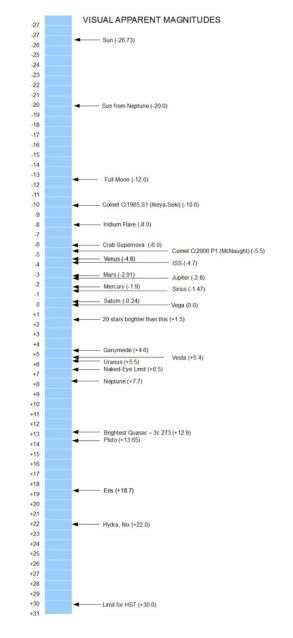The new forums will be named Coin Return (based on the most recent vote)! You can check on the status and timeline of the transition to the new forums here.
The Guiding Principles and New Rules document is now in effect.
Not the Bees!!! [SCIENCE]
QuestionMarkMan Registered User regular
Registered User regular
 Registered User regular
Registered User regular
SCIENCE

New Scientist talks about it, as does Harvard, and How Stuff Works
For decades astronomers have used the Astronomical Magnitude Scale to measure the brightness of stars. But what if they're measuring with an inaccurate ruler? And how could that screw up the quest to understand dark energy?
The Astronomical Magnitude Scale (see bottom of post) is a logarithmic scale used to measure the brightness of stars as seen from earth. The sun, our nearest star, is set at a value of roughly -27, but humans anywhere on earth can comfortably see all the way down to a value of zero. For values of +1 to +7, an observer would have to be in the country, away from light pollution. Trying to see anything brighter than +7 would mean breaking out the telescopes.
Scientists measure the brightness of astronomical objects by comparing the object's brightness to the brightness of reference stars. Vega and Sirius are popular references, since they have defined and well-known magnitudes.
Or do they? Despite the many advances in the practice, focus, and breadth of knowledge of astronomy, the apparent magnitude values of stars have been updated haphazardly, or not at all.
This faulty measuring system has bigger consequences than missing a twinkle or two. Astronomers use apparent magnitude to judge the distance of stars. Far-away stars are measured by determining their color spectrum and their apparent magnitude. The color spectrum of a star can tell scientists how bright it is. Why, then, do we need the Astronomical Magnitude Scale? Because it, in combination with the knowledge of the absolute brightness of a star, helps scientists determine how far away that star is.
A light that's shining in a person's face from two feet away is uncomfortable. From twenty feet away, it's enough to read by. From two hundred feet away, it's just a glimmer. By combining the knowledge of how bright the light is (spotlight, 60 watt bulb, candle flame) and how bright it appears, a person can roughly judge the distance from them to a light. Astronomers use the same process to determine how far away a star is. Imagine, however, that all throughout a person's life, they were told that a ten watt bulb was actually 60 watts. Their entire scale of reference would be thrown off, making it impossible for them to judge the distance of lights.
Once distance goes out the window, many measurements of the effects of dark energy go right out with it. Dark energy is the mysterious force that seems to be making the universe expand faster and faster over time. Scientists use the distance of stars to measure this expansion.
Picture yourself sitting on a rubber band as it is being stretched. Objects that are close by will be receding away at a certain rate of acceleration. However, objects that are farther away will be receding at a faster rate than nearby objects, because every part of the rubber band is expanding. The farther away an object is, the more material between it and you will be stretching out and pushing you apart.
If a scientist were to look at a star they mistakenly think is close by, and see it receding at an unexpectedly fast rate, they will come to erroneous conclusions about how fast the universe is expanding, and how great the force of dark energy is.
For want of a nail, the cosmological constant is lost.
Fortunately, there is a mission planned to take more accurate measurements of reference stars. Absolute Color Calibration Experiment for Standard Stars, or ACCESS, will give accurate and up-to-date information on the magnitude of the stars, and set a standard that can be used to give all scientists consistent data, and let all stargazers know exactly what they're seeing, and where they are seeing it.

New Scientist talks about it, as does Harvard, and How Stuff Works
QuestionMarkMan on
0
This discussion has been closed.
Posts
I was at an astronomy lecture last year and I remember the speaker talking about difficulties with measuring relative magnitudes especially in close clusters of stars, so this would be very neat if ACCESS could simplify things a bit
alchemy is where it's at
swoon
Chemistry is where it's at
Fleakers is where it's at
You get to be pip-squeak.
says the chef...
It was something like gravity behaves relativistically at lower energies and behaves more Newtonian-style at extremely high energies. Don't ask me to explain, I don't remember more than that.
"Think of it as Evolution in Action"
Leave my lab assistant alone.
Secret Satan 2013 Wishlist
became too dessicated
woops
All your fault.
There is a 12640 x 15546px, 341MB version of this image of the Orion Nebula:
"Think of it as Evolution in Action"
Taking a break after getting jailed over silly goosery.
Ambivalence and confusion?
More illicit and excited, like I'm about to get caught staring at secrets I'm not supposed to know but without actually having the knowledge or experience to truly appreciate or understand the full measure of what I'm looking at.
Also, totally aroused.
I feel guilt now like I did then. I need to confess to someone that I looked at it.
Do you mean glassware beaker or muppet Beaker?
yes
Magnetar.
Science thread, does anyone know where EECOM is? I want to try for John Aaron.